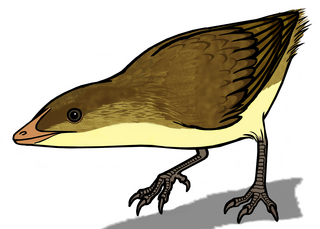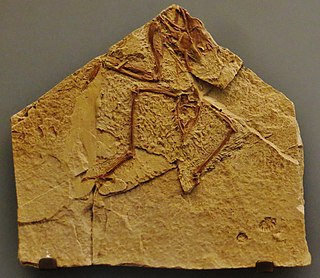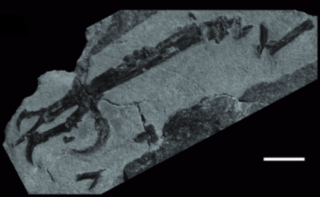
Saltasaurus is a genus of saltasaurid dinosaur of the Late Cretaceous period of Argentina. Small among sauropods, though still heavy by the standards of modern creatures, Saltasaurus was characterized by a short neck and stubby limbs. It was the first genus of sauropod known to possess armour of bony plates embedded in its skin. Such small bony plates, called osteoderms, have since been found on other titanosaurians.

Avisaurus is a genus of enantiornithine bird from the Late Cretaceous of North America.

Noasaurus is a genus of ceratosaurian theropod dinosaur genus from the late Campanian-Maastrichtian of Argentina. The type and only species is N. leali.
The Plottier Formation is a geologic formation that outcrops in the Argentine Patagonian provinces of Río Negro and Neuquén. It is the younger of two formations belonging to the Río Neuquén Subgroup within the Neuquén Group of the Neuquén Basin, with the oldest rocks dating from the late Coniacian and its youngest maybe from the very start of the Santonian. Formerly, that subgroup was treated as a formation, and the Plottier Formation was known as the Plottier Member.

The Anacleto Formation is a geologic formation with outcrops in the Argentine Patagonian provinces of Mendoza, Río Negro, and Neuquén. It is the youngest formation within the Neuquén Group and belongs to the Río Colorado Subgroup. Formerly that subgroup was treated as a formation, and the Anacleto Formation was known as the Anacleto Member.
Nanantius is a genus of extinct enantiornithean avialan known from the Early Cretaceous of Australia.
Enantiornis is a genus of Enantiornithes. The type and only currently accepted species E. leali is from the Late Cretaceous Lecho Formation at El Brete, Argentina. It was described from specimen PVL-4035, a coracoid, proximal scapula and proximal humerus found close to each other and suspected to represent the left shoulder of a single individual.

Yungavolucris is a genus of enantiornithean birds. It contains the single species Yungavolucris brevipedalis, which lived in the Late Cretaceous. The fossil bones were found in the Lecho Formation at estancia El Brete, Argentina."Yungavolucris brevipedalis" means "Short-footed Yungas bird". The generic name, Yungavolucris is after the Yungas region + the Latin volucris, which translates to "bird". The specific name brevipedalis is from the Latin brevis, which means "short", + pedalis, from the Latin pes, meaning "foot".

Lectavis is a genus of enantiornithine birds. Their fossil bones have been recovered from the Late Cretaceous Lecho Formation at estancia El Brete, Argentina. The genus contains a single species, Lectavis bretincola.

Eoalulavis is a monotypic genus of enantiornithean bird that lived during the Barremian, in the Lower Cretaceous around 125 million years ago. The only known species is Eoalulavis hoyasi.

Concornis is a genus of enantiornithean birds which lived during the early Cretaceous period, in the late Barremian age about 125 million years ago. Its remains are known from the Calizas de La Huérgina Formation at Las Hoyas, Cuenca province, Spain. The single known species, Concornis lacustris, was described from the remains of one fairly complete individual skeleton.
Neuquenornis volans is a species of enantiornithean birds which lived during the late Cretaceous period in today's Patagonia, Argentina. It is the only known species of the genus Neuquenornis. Its fossils were found in the Santonian Bajo de la Carpa Formation, dating from about 85-83 million years ago. This was a sizeable bird for its time, with a tarsometatarsus 46.8mm long. Informal estimates suggest that it measured nearly 30 cm (12 in) in length excluding the tail.

Avisauridae is a family of extinct enantiornithine dinosaurs from the Cretaceous period, distinguished by several features of their ankle bones. Depending on the definition used, Avisauridae is either a broad and widespread group of advanced enantiornithines, or a small family within that group, restricted to species from the Late Cretaceous of North and South America.

Bauxitornis is an extinct genus of avisaurid enantiornithean birds which lived in what is now Hungary during the late Cretaceous period. Although first mentioned in a 2008 review of Hungarian Cretaceous bird fossils, it was named in a more comprehensive review by Gareth J. Dyke and Attila Ősi in 2010. The type species is Bauxitornis mindszentyae. The generic name "Bauxitornis" refers to the locality at which it was discovered, a Bauxite mine. The specific name "mindszentyae" honors Andrea Mindszenty, Ősi's advisor.

Intiornis is an extinct genus of avisaurid enantiornithean birds which existed in what is now North-West Argentina during the late Cretaceous period.
Elbretornis is an extinct genus of enantiornithine which existed in what is now Salta Province, Argentina during the late Cretaceous period.
Martinavis is a genus of enantiornithine birds which existed in what is now southern France, North America and Salta Province, Argentina during the late Cretaceous period. It was named by Cyril A. Walker, Eric Buffetaut and Gareth J. Dyke in 2007, and the type species is Martinavis cruzyensis.
Gettyia is an extinct genus of avisaurid enantiornithean bird from the Late Cretaceous of North America.
Orienantius ritteri is an extinct genus of enantiornithine bird from the Lower Cretaceous of China.












